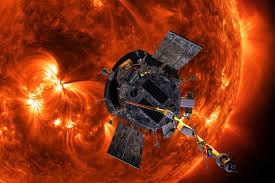
NASA said on Friday that its Parker Solar Probe was healthy and operating normally after accomplishing what no human-made object ever has: coming closer to the Sun.
On December 24, the spacecraft ventured within a remarkable 3.8 million miles (6.1 million kilometers) of the Sun’s surface, entering the corona, which is the Sun’s outer atmosphere. This groundbreaking mission aims to enhance scientists’ understanding of the Sun, Earth’s nearest star.
A beacon signal from the probe around midnight Thursday let Lab officials in Laurel, Maryland know it’s working. NASA reported: “Following its record-breaking closest approach to the Sun, Parker Solar Probe has sent a beacon tone back to Earth indicating it is in good health and operating normally.”
Detailed data on the probe’s status and experiences is expected to be transmitted on January 1. Scientists hope the mission will unravel how solar material heats up to millions of degrees, where the solar wind comes from, and how energetic particles reach almost the speed of light.
Traveling at speeds of 430,000 mph – 692,000 kph, the Parker Solar Probe withstood extreme temperatures as intense as 1,800 degrees Fahrenheit – 982 degrees Celsius. According to NASA, this close proximity to the Sun is vital for the probe to gather crucial measurements that scientists rely on to understand how material gets heated in this region and how it relates to the solar wind.
Nick Pinkine, mission operations manager at Johns Hopkins Applied Physics Laboratory said in a NASA blog, “No human-made object has ever passed this close to a star, so Parker will truly be returning data from uncharted territory.”
Right now, Parker Solar Probe is flying closer to a star than anything has ever been before,” Nicky Fox, a top official at NASA, said in a video posted on social media. “It’s just a total ‘yay, we did it’ moment.”.
Launched in 2018, the Parker Solar Probe has been incrementally closing in on the Sun, using Venus flybys to tighten its orbit. On its 2021 dive into the solar atmosphere, the probe unveiled fresh secrets about the Sun’s atmospheric edges and sent back stunning pictures of coronal streamers. One of its instruments also detected visible light from Venus, offering researchers a new way to study the planet’s surface beneath its thick clouds.



